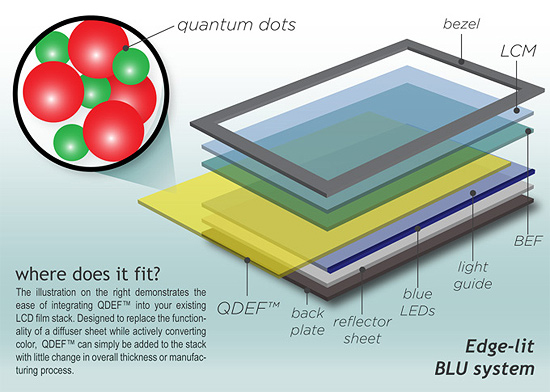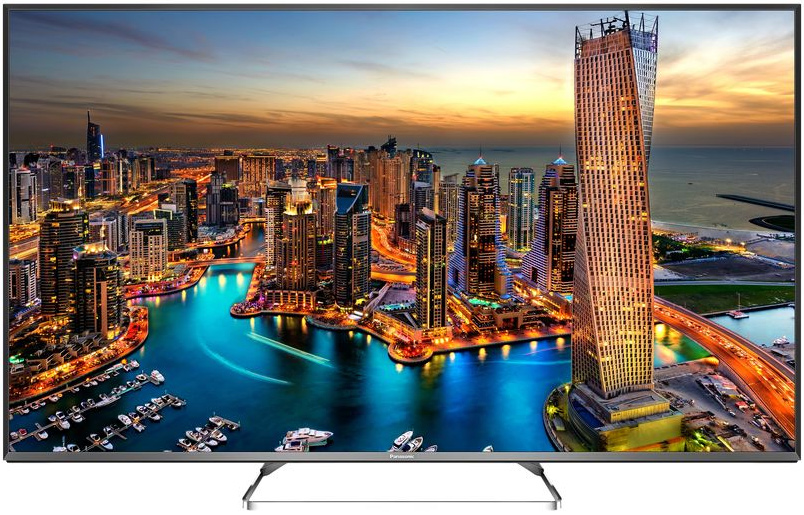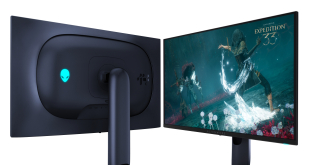AU Optronics Corp., one of the world’s leading makers of LCD panels for various devices, and 3M this week announced a new technology alliance that can dramatically improve quality of TV-sets and displays. The two companies will offer turn-key solutions that will help suppliers of televisions to offer TV-sets with quantum dot (QD) technology that enables wide color gamut and high dynamic range for ultra-high-definition (UHD) 4K TVs.
The QD display enhancement technology significantly improves quality of backlighting in LED LCD panels by integrating a special quantum dot enhancement film (QDEF) with trillions of semiconductor nanocrystals into an LCD panel stack. A quantum dot can emit (or, in the case of QDEF, filter) light at a very precise wavelength. The ability to control the spectral output of a quantum dot allows QDEF to create an ideal white backlight, something that allows to display more accurate red, green and blue colours, thus enhancing color gamut.
“The exciting thing is that the LCD industry is on the verge of a color revolution,” said Erik Jostes, business director for 3M display materials and systems division. “Quantum dot materials enable displays to produce colors richer than any other technology, providing life-like images of a quality never seen before.”

AUO claims that its LCD LED panels with 3M’s QDEF tech will help to build TVs and displays compliant with ITU-R Recommendation BT.2020 (better known as Rec. 2020) for ultra-high-definition TVs. In addition to 3840*2160 and 7680*4320 resolutions, the Rec. 2020 also supports bit depth of either 10-bits per sample or 12-bits per sample, which means that Rec. 2020-compliant devices can reproduce colours that were not shown on previous-gen displays. Ultra HD Blu-ray discs and players fully support all the aspects of the Rec. 2020, including display resolution, frame rate, chroma subsampling, bit depth, and color space. Essentially, Rec. 2020 is must-have feature for modern Ultra HD TVs.
AUO Optronics will offer various 4K TV panels featuring 3M’s quantum dot enhancement film with up to 85” size. TV brands will have to equip such panels with appropriate electronics to take advantage of the QDEF technology. Mass production of the new display panels will begin by the end of this year.
The dot enhancement film replaces a similar film already found inside LCD backlights, which means that adding QDEF to manufacturing processes required no new equipment or process changes for AUO. Unfortunately, it is unknown how much does a single quantum dot enhancement film cost.
It is unknown who of AUO’s customers will use its advanced LCD panels with QDEF. AUO supplies panels to companies like Apple, Dell, Hewlett-Packard, Panasonic, Sony, Toshiba and a lot of less known makers of PCs and televisions.
Sony was the first company to offer TVs with QDEF technology in 2013. At present, Samsung Electronics, LG Electronics and TCL also sell QD-enhanced TVs.
Discuss on our Facebook page, HERE.
KitGuru Says: Could the collaboration between AUO and 3M eventually lead to creation of Apple’s TV-set with QD-enhanced panel? That’s a possibility, but it is more likely that the partnership will help brands like Panasonic and Toshiba to take advantage of quantum dot technology and improve quality of their products. Besides, little known brands could significantly improve quality of their products and offer TVs that provide image quality on par with devices produced by leading manufacturers.
 KitGuru KitGuru.net – Tech News | Hardware News | Hardware Reviews | IOS | Mobile | Gaming | Graphics Cards
KitGuru KitGuru.net – Tech News | Hardware News | Hardware Reviews | IOS | Mobile | Gaming | Graphics Cards





What’s the performance of these panels, compared to OLED panels?
Not even close.
Though they won’t have life expectancy issues if I remember correctly.
One thing I want to see is 1440p/4K QD-IPS, it would be good for both consumers and professionals.. QD-TN won’t.
Another patch for an obsolete technology.
Check this video from “quantum” top of the line Samsung 4K SUHD vs the LG 4K OLED, the OLED simply destroys the sammy in contrast, picture quality, accurate colors, whatever you want its like your watching the animals from a window.
https://www.youtube.com/watch?v=-ogjW7NLD8w
The only thing that most of people don’t notice such difference is that you’re probably using an LCD monitor, not a plasma, oled or crt based screen (maybe VA panel).
WORKAT HOME SPECIAL REPORT………After earning an average of 19952 Dollars monthly,I’m finally getting 98 Dollars an hour,just working 4-5 hours daily online….It’s time to take some action and you can join it too.It is simple,dedicated and easy way to get rich.Three weeks from now you will wishyou have started today – I promise!….HERE I STARTED-TAKE A LOOK AT….yu……
➤➤➤➤ http://googleteambuzznetplanedworkzone/start/earning/…. ⚛⚛⚛⚛⚛⚛⚛⚛⚛⚛⚛⚛⚛⚛⚛⚛⚛⚛⚛⚛⚛⚛⚛⚛⚛⚛⚛⚛⚛⚛⚛⚛⚛⚛⚛
only for TV ? let they do it for monitors too
Obsolete? Huh. Science time, I suppose.
Quantum dots have two major drawbacks over OLED:
1) Producing blue quantum dots is hard, and by hard, I mean ridiculously expensive.
2) Putting them all on a substrate with extreme accuracy is hard, and by hard, I mean expensive.
The solution to these is why what we call Quantum Dot Displays aren’t really Quantum Dot Displays. They are regular LCD screens that use QD backlighting for reds and greens, while the blues are just filtered LED backlighting. The distribution of the quantum dots isn’t anywhere near perfect (but doesn’t quite have to be) for these purposes… but it is still a better solution than the current standard for backlighting. It is also far cheaper than OLED solutions, which are used as pixels and a light source in one (allowing for super thin screens, no dependence on backlighting which gives blacker blacks and excellent contrast ratios, and so on).
OLED has some major drawbacks of it’s own in comparison with quantum dots:
1) They degrade over time (that’s the “O”rganic in OLED).
2) Keeping a pixel on at the same color over long periods causes it to burn (either keeping it as one color, or as a black pixel).
3) Mass production for reds and greens isn’t as cheap as quantum dots.
4) They aren’t quite as power efficient as quantum dots.
The solution to these issues is simple: don’t use OLED in things where they might be on for extended periods of time (which is why they are used in TVs and smartphones, yet not as PC monitors). The worse problem (though it is quite the advantage for the manufacturers) is that a product has a built in limit to how long it can be used. This is also why the price just doesn’t seem to get reasonable for this tech.
Once quantum dots tech solves the issue of blue dot production, then we will start seeing a true comparison of technologies: full arrays of quantum dots will compete with full arrays of OLEDs. Until then, comparing the technologies is ridiculous – you are comparing LED-Backlight v2 LCDs to a full-array of OLEDs. Also, you’re comparing a product that costs a tenth the price to a premium high end one.
Quantum dots aren’t ready for full-scale use yet. This is a fledgling technology. Once the issues are solved, it is primed to compete with OLED. I actually love the fact that this tech has found it’s use without going all-out, which means that over time there will be money enough in it to solve the issues. The most exciting thing would probably not be TVs/monitors though – it will be in lighting. Quantum dots are theoretically the most power efficient, and therefore least heat emitting, sources of light. As opposed to LED light bulbs, there would probably be no issue with those annoyingly big parts just so it won’t expend all that heat into such a small area.
This is exciting tech. Of course it can’t compete with OLED right now. But it holds a lot of promise, and is theoretically the best solution humanity can come up with in the next couple of decades… if it makes it to practice, everyone wins.